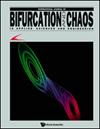Ultra-Chaos in the Motion of Walking Droplet
IF 2.3
4区 数学
Q2 MATHEMATICS, INTERDISCIPLINARY APPLICATIONS
引用次数: 0
Abstract
A liquid bath vibrating vertically can lead to the emergence of a self-propelled walking droplet on its free surface, which can exhibit chaotic motion. It is well-known that trajectories of a chaotic system are sensitive to its initial condition, known as the “butterfly-effect”, while its statistics normally remain stable to small disturbances: this type of chaos is called “normal-chaos”. However, a concept called “ultra-chaos” has been recently introduced, whose statistical features are unstable, i.e. extremely sensitive to small disturbances. Up to now, a few examples of ultra-chaos have been reported. In this paper, the influence of tiny disturbances on the motion of walking droplet is investigated. It is found that both normal-chaos and ultra-chaos exist in the motion of the walking droplet. Different from the normal-chaotic motion, even the statistical properties of the droplet’s ultra-chaotic motion are sensitive to tiny disturbances. Therefore, this illustrates once again that ultra-chaos indeed exists widely and represents a higher disorder compared with normal-chaos. The ultra-chaos as a new concept can widen our knowledge about chaos and provide us with a new point of view to study chaotic properties. It should be emphasized that, for an ultra-chaos, it is impossible to repeat any results of its physical experiments or numerical simulations even in the meaning of statistics! Unfortunately, reproducibility is a corner stone of modern science. Thus, the paradigm of modern scientific research might be invalid for an ultra-chaotic system.行走水滴运动中的超混沌现象
垂直振动的液槽会导致在其自由表面上出现自走液滴,这种液滴会表现出混沌运动。众所周知,混沌系统的轨迹对其初始条件很敏感,这被称为 "蝴蝶效应",而其统计量通常对小的干扰保持稳定:这种类型的混沌被称为 "正常混沌"。然而,最近又出现了一种被称为 "超混沌 "的概念,其统计特征是不稳定的,即对微小扰动极其敏感。迄今为止,关于超混沌的报道屈指可数。本文研究了微小扰动对行走液滴运动的影响。研究发现,行走液滴的运动中同时存在正混沌和超混沌。与正常混沌运动不同,液滴超混沌运动的统计特性对微小扰动也很敏感。因此,这再次说明超混沌确实广泛存在,而且与正常混沌相比代表了更高的无序性。超混沌作为一个新概念,可以拓宽我们对混沌的认识,为我们研究混沌特性提供一个新的视角。需要强调的是,对于超混沌来说,其物理实验或数值模拟的任何结果都不可能重复,即使在统计学意义上也是如此!不幸的是,可重复性是现代科学的基石。因此,现代科学研究的范式对于超混沌系统来说可能是无效的。
本文章由计算机程序翻译,如有差异,请以英文原文为准。
求助全文
约1分钟内获得全文
求助全文
来源期刊
CiteScore
4.10
自引率
13.60%
发文量
237
审稿时长
2-4 weeks
期刊介绍:
The International Journal of Bifurcation and Chaos is widely regarded as a leading journal in the exciting fields of chaos theory and nonlinear science. Represented by an international editorial board comprising top researchers from a wide variety of disciplines, it is setting high standards in scientific and production quality. The journal has been reputedly acclaimed by the scientific community around the world, and has featured many important papers by leading researchers from various areas of applied sciences and engineering.
The discipline of chaos theory has created a universal paradigm, a scientific parlance, and a mathematical tool for grappling with complex dynamical phenomena. In every field of applied sciences (astronomy, atmospheric sciences, biology, chemistry, economics, geophysics, life and medical sciences, physics, social sciences, ecology, etc.) and engineering (aerospace, chemical, electronic, civil, computer, information, mechanical, software, telecommunication, etc.), the local and global manifestations of chaos and bifurcation have burst forth in an unprecedented universality, linking scientists heretofore unfamiliar with one another''s fields, and offering an opportunity to reshape our grasp of reality.

 求助内容:
求助内容: 应助结果提醒方式:
应助结果提醒方式:


